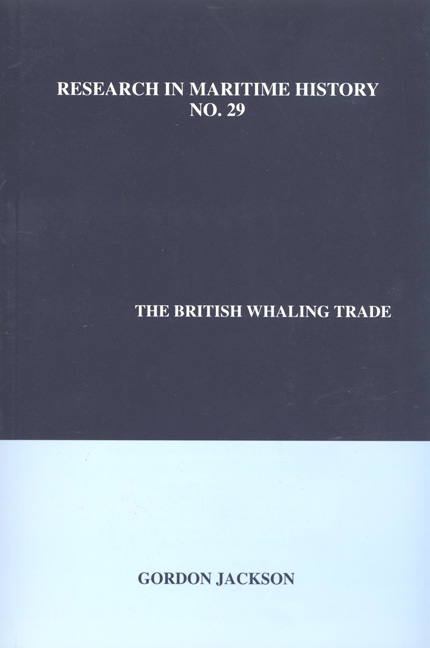Book contents
- Frontmatter
- Dedication
- Contents
- List of Tables in the Text
- List of Appendices
- New Introduction
- Preface
- Part One The Traditional Whaling Trades, 1604-1914
- Chapter 1 Northern Adventures and the Spitsbergen Trade, c. 1604-1670
- Chapter 2 Lost Hopes and Expensive Failures, c. 1670-1750
- Chapter 3 The Rise of the Greenland Trade, 1750-1783
- Chapter 4 The Boom in the Northern Fishery, 1783-c. 1808
- Chapter 5 Expansion South of the Arctic Seas, c. 1776-c. 1808
- Chapter 6 Decline in the North in the Early Nineteenth Century
- Chapter 7 Expansion and Failure of the Southern Fishery, c. 1808-1840
- Chapter 8 The End of the Northern Fishery in the late Nineteenth Century
- Part Two The Modern Whaling Trade, 1904-1963
- Conclusion
- Appendices
- Select Bibliography
- Additional Bibliography
- Index
Chapter 4 - The Boom in the Northern Fishery, 1783-c. 1808
from Part One - The Traditional Whaling Trades, 1604-1914
- Frontmatter
- Dedication
- Contents
- List of Tables in the Text
- List of Appendices
- New Introduction
- Preface
- Part One The Traditional Whaling Trades, 1604-1914
- Chapter 1 Northern Adventures and the Spitsbergen Trade, c. 1604-1670
- Chapter 2 Lost Hopes and Expensive Failures, c. 1670-1750
- Chapter 3 The Rise of the Greenland Trade, 1750-1783
- Chapter 4 The Boom in the Northern Fishery, 1783-c. 1808
- Chapter 5 Expansion South of the Arctic Seas, c. 1776-c. 1808
- Chapter 6 Decline in the North in the Early Nineteenth Century
- Chapter 7 Expansion and Failure of the Southern Fishery, c. 1808-1840
- Chapter 8 The End of the Northern Fishery in the late Nineteenth Century
- Part Two The Modern Whaling Trade, 1904-1963
- Conclusion
- Appendices
- Select Bibliography
- Additional Bibliography
- Index
Summary
However humiliating for the politicians and soldiers, the peace of 1783 was the signal for an immense expansion of the British economy and a consequent rise in the demand for all manner of raw materials. So far as the oil trade was concerned, the peace terms removed at a stroke the most damaging competitors. “We are surprised,” said John Adams, the America minister in London, “that you prefer darkness and consequent robberies, burglaries and murders in your streets, to the receiving, as a remittance, our spermaceti oil.” It was many years before the Americans were reconciled to the fact that they were either colonists or foreigners; and despite many valiant efforts at compromise, foreigners they remained. (It was an ironic touch that the first British ambassador to the USA, George Hammond, was the son of an English whaler-owner.) Imports from America, which now bore heavy duty, were running at about a tenth of prewar levels, and ceased altogether by 1793. The American trade was, for a time, suspended, but the street lamps stayed alight. British oil merchants and shipowners, realising the implication that Adams missed, raced to serve their own market. Oil was now provided by a rapid expansion of the British fishery in the Arctic - with the number of Greenland whalers rising from forty-four in 1782 to 102 in 1784 - and by the exciting novelty of a new British initiative in whaling to the south of the traditional Northern Fishery zone. Fore the sake of clarity the former fishery will be dealt with in the present chapter, and the latter fishery in the following chapter.
The exceptional growth in the number of Arctic whalers operating from English ports after 1783 was encouraged in other ways when war ended. The largest vessels employed in the trade consisted of many “sold by the Commissioners of HM Navy, others that have been transports, armed ships and privateers, most of them fit for no other trade or employment but the Greenland Fishery being sharp ships and not burthensome.” Nor was it simply a case of the navy selling redundant ships.
- Type
- Chapter
- Information
- The British Whaling Trade , pp. 61 - 80Publisher: Liverpool University PressPrint publication year: 2004



